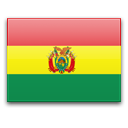More details
Bolivia (; Spanish: [boˈliβi̯a]; Guarani: Mborivia [ᵐboˈɾiʋja]); Quechua: Buliwya [bʊlɪwja]; Aymara: Wuliwya [wʊlɪwja]; [ᵐboˈɾiʋja]), officially known as the Plurinational State of Bolivia (Spanish: Estado Plurinacional de Bolivia), is a landlocked country located in western-central South America. It is bordered to the north and east by Brazil, to the southeast by Paraguay, to the south by Argentina, to the southwest by Chile, and to the northwest by Peru. One-third of the country is the Andean mountain range.
The largest city and principal economic and financial center is Santa Cruz de la Sierra, located on the Llanos Orientales (Tropical lowlands) mostly flat region in the East of Bolivia. Bolivia is one of two landlocked countries (the other is Paraguay) that lie outside Afro-Eurasia. Bolivia is geographically the largest landlocked country in the Americas, but remains a relatively small country in economic and military terms.
Before Spanish colonization, the ...
Andean region of Bolivia was part of the Inca Empire, while the northern and eastern lowlands were inhabited by independent tribes. Spanish conquistadors arriving from Cuzco and Asunción took control of the region in the 16th century. During the Spanish colonial period Bolivia was administered by the Royal Audiencia of Charcas. Spain built its empire in great part upon the silver that was extracted from Bolivia's mines.
After the first call for independence in 1809, 16 years of war followed before the establishment of the Republic, named for Simón Bolívar, on 6 August 1825. Since independence, Bolivia has endured periods of political and economic instability, including the loss of various peripheral territories to its neighbors, such as Acre and parts of the Gran Chaco. It has been landlocked since the annexation of its Pacific coast territory by Chile following the War of the Pacific (1879–84), but agreements with neighboring countries have granted it indirect access to the Pacific and Atlantic oceans.
The country's population, estimated at 11 million, is multiethnic, including Amerindians, Mestizos, Europeans, Asians and Africans. The racial and social segregation that arose from Spanish colonialism has continued to the modern era. Spanish is the official and predominant language, although 36 indigenous languages also have official status, of which the most commonly spoken are Guarani, Aymara and Quechua languages.
Modern Bolivia is constitutionally a unitary state, divided into nine departments. Its geography varies from the peaks of the Andes in the West, to the Eastern Lowlands, situated within the Amazon Basin. It is a developing country, with a medium ranking in the Human Development Index and a poverty level of 53 percent. Its main economic activities include agriculture, forestry, fishing, mining, and manufacturing goods such as textiles, clothing, refined metals, and refined petroleum. Bolivia is very wealthy in minerals, especially tin.
Source: wikipedia


